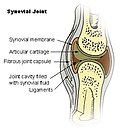Synovial membrane
Synovial membrane or synovium is a specialized connective tissue that lines the inner surface of capsules of synovial joints and tendon sheath. It makes direct contact with the synovial fluid lubricant, which it is primarily responsible for maintaining. In contact with the synovial fluid at the tissue surface are many rounded macrophage-like synovial cells and type B synovial cells.
Structure[edit]
The synovial membrane is a thin, smooth layer of connective tissue that lines the surfaces of the joint capsule and secretes synovial fluid. It is primarily made up of two types of cells, but is also contains fat cells and is surrounded by a network of blood vessels and lymphatic vessels.
Cells[edit]
The synovial membrane is primarily made up of two types of cells. These are type A synovial cells and type B synovial cells. Type A synovial cells are similar to macrophages and are responsible for the removal of wear-and-tear debris from the synovial fluid. Type B synovial cells are responsible for the secretion of hyaluronan and lubricin, the two main components of the synovial fluid.
Function[edit]
The synovial membrane's main function is to produce and maintain the synovial fluid, a thick, clear liquid that lubricates the joints and allows for smooth movement. The synovial fluid also provides nutrients to the avascular articular cartilage and removes waste products from the joint capsule.
Clinical significance[edit]
Diseases and conditions that affect the synovial membrane can lead to joint pain and loss of function. These include rheumatoid arthritis, osteoarthritis, gout, and lupus. In these conditions, the synovial membrane becomes inflamed and thickened, leading to an overproduction of synovial fluid and causing pain and swelling in the joint.
See also[edit]
References[edit]
<references />
Ad. Transform your life with W8MD's Budget GLP-1 injections from $75


W8MD offers a medical weight loss program to lose weight in Philadelphia. Our physician-supervised medical weight loss provides:
- Weight loss injections in NYC (generic and brand names):
- Zepbound / Mounjaro, Wegovy / Ozempic, Saxenda
- Most insurances accepted or discounted self-pay rates. We will obtain insurance prior authorizations if needed.
- Generic GLP1 weight loss injections from $75 for the starting dose.
- Also offer prescription weight loss medications including Phentermine, Qsymia, Diethylpropion, Contrave etc.
NYC weight loss doctor appointmentsNYC weight loss doctor appointments
Start your NYC weight loss journey today at our NYC medical weight loss and Philadelphia medical weight loss clinics.
- Call 718-946-5500 to lose weight in NYC or for medical weight loss in Philadelphia 215-676-2334.
- Tags:NYC medical weight loss, Philadelphia lose weight Zepbound NYC, Budget GLP1 weight loss injections, Wegovy Philadelphia, Wegovy NYC, Philadelphia medical weight loss, Brookly weight loss and Wegovy NYC
|
WikiMD's Wellness Encyclopedia |
| Let Food Be Thy Medicine Medicine Thy Food - Hippocrates |
Medical Disclaimer: WikiMD is not a substitute for professional medical advice. The information on WikiMD is provided as an information resource only, may be incorrect, outdated or misleading, and is not to be used or relied on for any diagnostic or treatment purposes. Please consult your health care provider before making any healthcare decisions or for guidance about a specific medical condition. WikiMD expressly disclaims responsibility, and shall have no liability, for any damages, loss, injury, or liability whatsoever suffered as a result of your reliance on the information contained in this site. By visiting this site you agree to the foregoing terms and conditions, which may from time to time be changed or supplemented by WikiMD. If you do not agree to the foregoing terms and conditions, you should not enter or use this site. See full disclaimer.
Credits:Most images are courtesy of Wikimedia commons, and templates, categories Wikipedia, licensed under CC BY SA or similar.
Translate this page: - East Asian
中文,
日本,
한국어,
South Asian
हिन्दी,
தமிழ்,
తెలుగు,
Urdu,
ಕನ್ನಡ,
Southeast Asian
Indonesian,
Vietnamese,
Thai,
မြန်မာဘာသာ,
বাংলা
European
español,
Deutsch,
français,
Greek,
português do Brasil,
polski,
română,
русский,
Nederlands,
norsk,
svenska,
suomi,
Italian
Middle Eastern & African
عربى,
Turkish,
Persian,
Hebrew,
Afrikaans,
isiZulu,
Kiswahili,
Other
Bulgarian,
Hungarian,
Czech,
Swedish,
മലയാളം,
मराठी,
ਪੰਜਾਬੀ,
ગુજરાતી,
Portuguese,
Ukrainian





